How Jorge Jesus turned Flamengo into a title contender
In little over three months of work, Portuguese manager Jorge Jesus can safely say that he has won the hearts of the fans of the Brazilian team with the largest following.
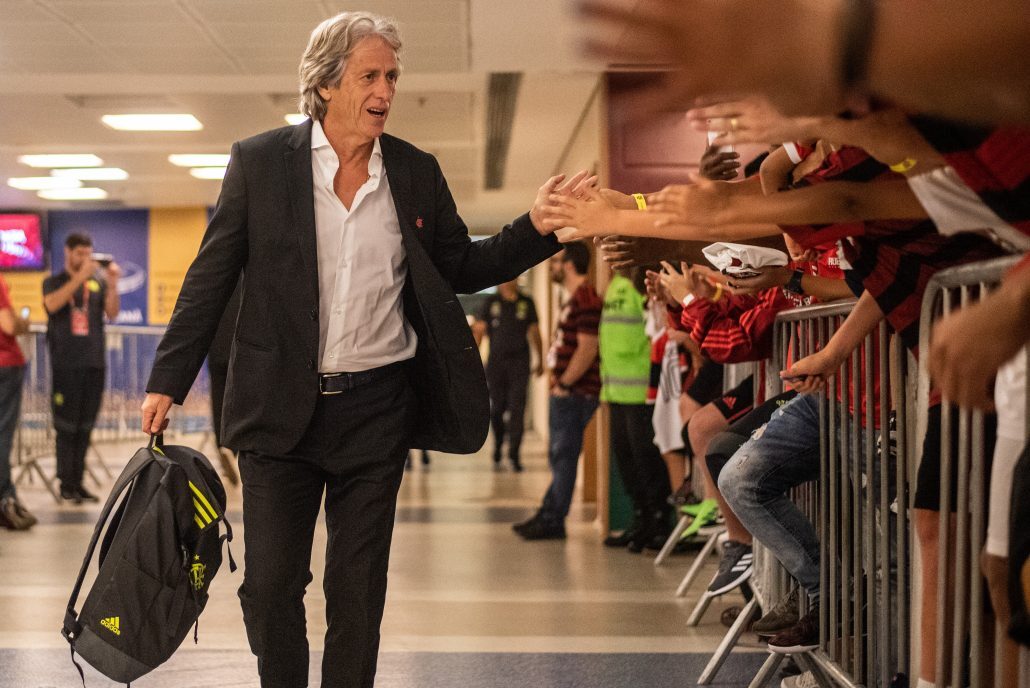
Below, we’ll be delving into Jorge Jesus’ game strategy for the most popular team in Brazil. The excellent implementation of these ideas, added to the quality of the squad, has made the fans dream of the coveted Copa Libertadores, a tournament they last won in 1981 when star player Zico was still there. Flamengo winning and enchanting with the Portuguese coach. He produces eminently watchable football that’s in line with the club’s offensive DNA.
Jorge Jesus’ quality as a coach is unquestionable. He did great work in Portugal and his time in Saudi Arabia got off to a good start. The question was the European man’s adaptation to playing in Brazil. There are a lot of differences. The pitches are different, the weather conditions prevent high intensity in lots of games, the Brazilian football calendar is insane and poorly planned, and the players are treated more paternalistically by the clubs. The atmosphere isn’t as strict and extremely professional as in Europe, but Jesus has been able to change some realities quite quickly.
Starting with the behaviour of the players. The Flamengo fans are some of the most demanding in Brazil. In recent years, they’ve been complaining about the lack of commitment from some players. Jorge Jesus has publicly praised how the red and blacks have been throwing themselves into their everyday work. The intensity seen on the pitch during the games is also above average for Brazilian football. These pillars, while somewhat subjective, are important for the performance seen so far.
Tactical Scheme
The team formation varies a lot. Jorge Jesus became known for using 4-1-3-2, but he only used it in the first games in Brazil. The formation most used by Flamengo is 4-4-2, with two players more aligned towards the centre, two wingers with the freedom to move towards the centre, and total mobility of the front pair made up of Bruno Henrique and Gabigol. Sometimes, 4-2-3-1 is used, with Everton Ribeiro in a more central position and Bruno Henrique on the right. But what attracts attention is the number of times this is varied during the matches. And how the players quickly understood the pattern of movement according to each tactical scheme.
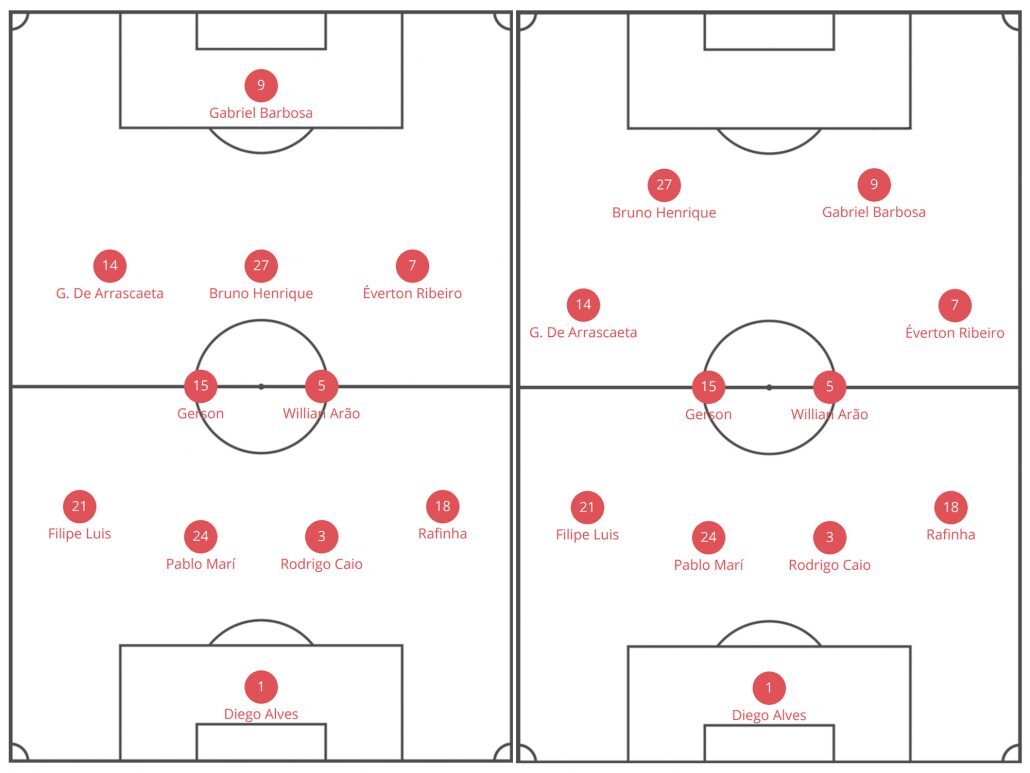
Offensive Phase
The word that best defines Flamengo’s attack under Jorge Jesus is uprightness. No matter how much it dominates ball possession in its matches, it’s not a team for long possession and constant passes. When it has the advantage on the field, it even takes on a more controlling nature, but its essence is the speed with which it builds its attacks. The gains in depth through the speed and movements of Gabigol and Bruno Henrique. The quality of the coordination between Everton Ribeiro and Gérson, the versatility of Willian Arão and the deadliness of De Arrascaeta.
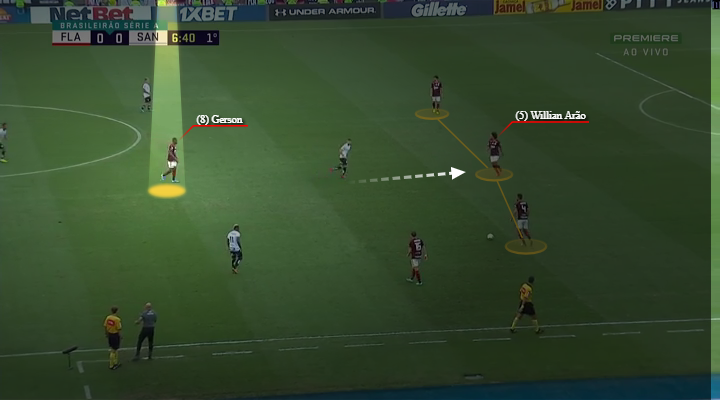
At this time, it’s also important to emphasise the participation of the defensive quartet. Rodrigo Caio and Pablo Mari are centre backs who make excellent passes. The ball goes well from the first moment it’s kicked. Filipe Luís and Rafinha are coordinating wingers. Several times, they occupy the flanks according to the ideas of Jorge Jesus, dictating the rhythm of the team with all their experience and the high level they’ve achieved in their careers.
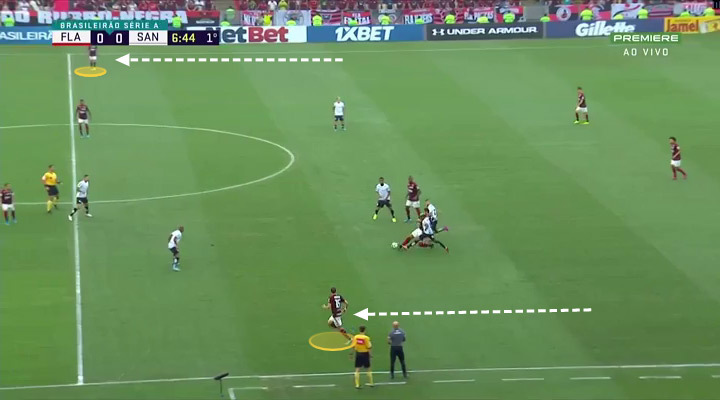
Whatever the tactical scheme adopted, Flamengo uses a goal kick play with three players aligned initially. Willian Arão infiltrates the centre backs and frees up Rafinha and Filipe Luís. They occupy the flanks of the field of attack, making room for the team to move the ball and get through the opposing defence. Gérson, playing very well at Flamengo, is the one who gives the touch of centralised quality. He distributes the plays. Everton Ribeiro and De Arrascaeta float around the centre, “attacking” their opponent’s last line of defence. They wreak havoc on the last third of the pitch with Bruno Henrique and Gabigol.
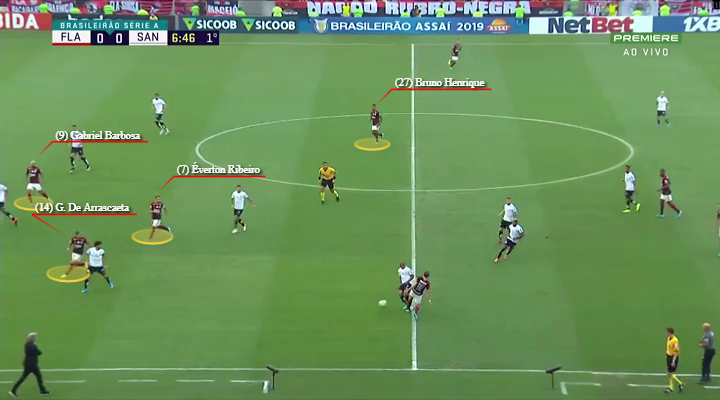
Game by game, Flamengo has become more intelligent in its occupation of spaces near the opposing goal. During the first few games, there was often a certain imbalance because of this extreme freedom Jorge Jesus was giving to his more advanced players. At times, there was a lack of breadth, the presence among the opposing lines or depth, but this has been slowly disappearing. What we see now is a Flamengo that is mobile, fast, forceful and taking advantage of the different characteristics of its frontmen. Gabigol already has 30 goals this season, for example.
Defensive Phase
As for defensive organisation, Flamengo uses zonal marking in the sector and some pursuits. But they’re not long. It’s unusual to see one of the wingers of the Rubro-Negro moving far from their area of operation to follow an opposing player. The pursuits take place in predetermined areas so as not to disorganise the team’s positioning. In the first games with Jesus, the defence had a lot of holes, but since mid-August, there has been a considerable improvement in the number of clear chances generated by the opposing team and, consequently, a fall in the average number of goals conceded.
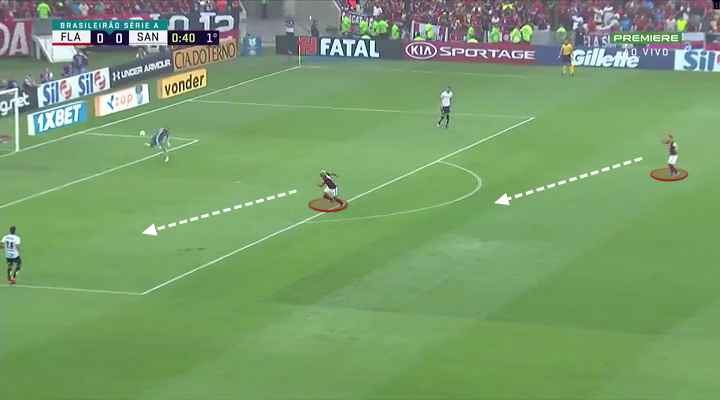
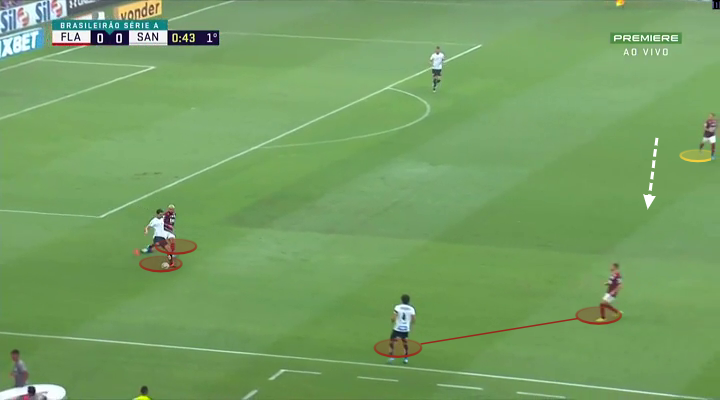
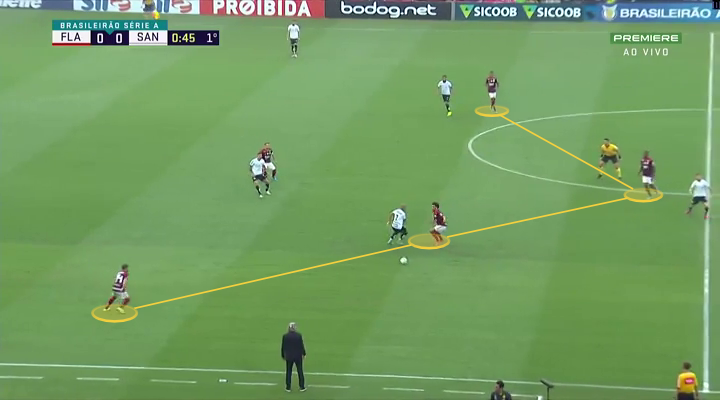
Part of this scenario comes majorly from the understanding of compressing and marking harder in the field of attack. These concepts still need much exploration in Brazilian football, and Jorge Jesus will certainly add a lot to this. Flamengo positions itself with very close lines between the defence and midfield, it approaches its adversary very intensively when the time comes to attacks, and counts on the active participation of the strikers. After all, if they don’t put pressure on, the player with the ball is free to make a long forward pass. The arrivals of Rafinha and Filipe Luís were decisive for the good operation of the coverage on the last defensive line. Diego Alves also realised that you have to play a bit further ahead to give the necessary cover and for things to come together.
Transitions
Flamengo has scored a lot of goals from counter-attacks under Jorge Jesus. Not that this has been the case from the beginning of the matches. On the contrary, they take the initiative in attacking, but they’re lethal when they have room to run. Gabigol and Bruno Henrique are two players who are cut out for this kind of play. De Arrascaeta has an excellent perception of the last metres of the pitch. Everton Ribeiro isn’t fast, but he guides the ball masterfully and provides very capable assists. Rafinha and Filipe Luís get the ball moving. Gérson and Arão are dynamic. Apart from this entire range of technical options, there is collective organisation and coordination of movements to make the most of the room available.
For defensive transitions, the idea the “Mister” has is to provide immediate intensity to get the ball back. The “lose, put pressure on” tactic is increasingly being executed in a more coordinated manner by the team. Gérson and Willian Arão are the backbone of the team at the moment. As they play very offensively, they’re almost always near the ball and they begin putting this pressure on. Flamengo has conceded very few goals to rival counter attacks.
How far can Flamengo go?
This question is asked every day by the club’s huge following. Football is a completely unpredictable sport. Very often, big teams start off very well, but then something makes their performance wane. There are a lot of variables that influence and yearning after a major title are irresponsible. However, the fact remains that, at the moment, Flamengo is playing the best football it’s played in many years. The most enthusiastic are making comparisons with the club’s golden generation in the 1980s. Exaggeration aside, the red and blacks have never been so close to winning the coveted titles.